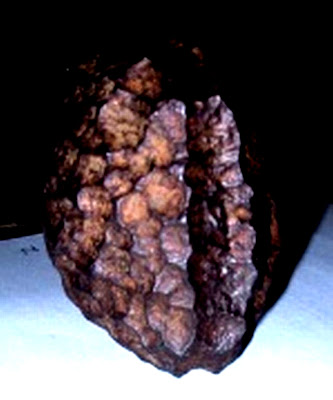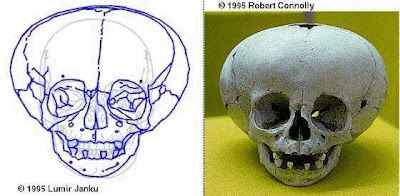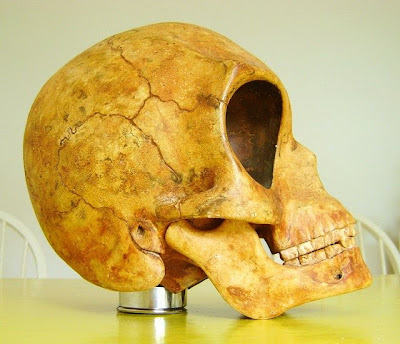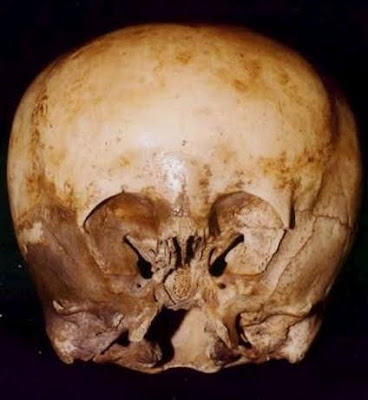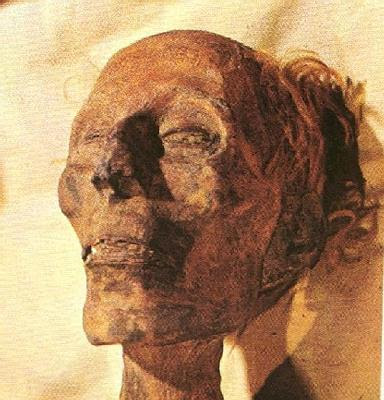
Mummies is a term that today is used to describe natural or artificially preserved bodies, though traditionally the word was used specifically to describe the bodies of ancient Egyptians where dehydration of the tissues was used to prevent putrefaction.
The word is derived from the Persian or Arabic word mumia (or mumiya), which means “pitch” or “bitumen”. It originally referred to a black, asphalt-like substance, thought to have medicinal properties and eagerly sought as a cure for many ailments, that oozed from the “Mummy Mountain” in Persia.
There was such a demand for this substance that an alternative source was eventually sought and, because the ancient Egyptian mummies often have a blackened appearance, they were believed to possess similar properties to munia. Hence, during the medieval and later times, they were used as medicinal ingredient. The term mumia, or “mummy” was therefore extended to these bodies and has continued in use up until our present day.
Mummification of bodies was originally a natural process in Egypt and elsewhere, where the dryness of the sand in which the body was buried, the heat or coldness of the climate, or the absence of air in the burial helped to produce unintentional or “natural” mummies. These processes have produced mummies not only in Egypt, but in South America, Mexico, the Alps, Central Asia, the Canary Islands, the Aleutian Islands and Alaska. Another type of natural mummification also occurred in northwestern Europe where bodies have been preserved when buried in peat bogs or fens containing lime.
In some of these areas, the natural process was early on intentionally developed by enhancing the environmental conditions. Sun, fire or other sources of heat were sometimes used to dehydrate the bodies, while at other times, the bodies were cured using smoke. Also, natural material such as grass could be used to surround the body, fill its cavities or seal the burial place so that, by the exclusion of air, decomposition and further deterioration was prevented.
Our Sources and Research on Mummification

What we know about Egyptian mummification comes from a number of sources, including the archaeological evidence provided by the mummies themselves, paleopathological studies of the bodies, painted and carved representations in tomb scenes and elsewhere that depict some stages of the mummification process, and textual references in Egyptian and other classical era accounts. However, there exists no known Egyptian description of the technical processes involved in mummification. No paintings or carvings provide an extant, complete record of mummification, though some wall scenes in the tombs of Thoy and Amenemope (tombs 23 and 41 on the West Bank at Thebes, respectively) and vignettes painted on some coffins and canopic jars show some stages in the mummification process. However, the earliest known accounts of mummification that are relatively complete occur in the writings of two specific An older x-ray of the head of Ramesses IIGreek historians (Herodotus from the fifth century BC and Diodorus Siculus from the first century BC).
Nevertheless, within Egyptian literature, there is scattered references to mummification and the associated religious rituals. In one text, called the “Ritual of Embalming”, is provided a set of instructions to the officials who perform the rites that accompany the mummification process, as well as a collection of prayers and incantations to be invoked after each rite. This ritual is specifically set out in two papyri, probably copied from the same source and both dated to the Roman period. They are the Papyrus Boulaq 3, now in the Cairo Museum, and Papyrus 5158 in the Louvre. There are also references to the embalming ceremonies in the Rhind Papyri and in other literary sources, including inscriptions on stelae. However, it is Herodotus’s account that remains the most complete regarding the mummification process.
In addition to classical texts and references, a surprising amount of modern scientific research has been conducted in regards to mummies. Sometimes,. these have even included multidisciplinary studies of mummified remains which have supplied new information about the process of mummification itself, as well as disease, diet, living and working conditions and even family relationships. For example, the use of scanning electron microscopes has been used to identify insects that attack mummies, histology and electron microscopy have supplied evidence about the success or failure of individual mummification techniques, and thin layer and gas liquid chromatography have isolated and characterized the substances that were applied to the mummy bandages.
Results of a ct or Cat Scan of an unidentified female mummy.There have also been several techniques that have informed us of the diseases in mummies. As early as the 1970s, radiography, which is a nondestructive method, became a major investigative procedure and later the additional use of computerized tomography (CT) became standard in most radiological investigations of mummies. There are also dental studies of mummies that have provided evidence about age, diet, oral health and disease. Paleohistology, which involves the rehydration, fixing and selective staining of sections of mummified tissue, together with paleopathology, which is the study of disease in ancient people, have developed considerably since the techniques were originally pioneered in Cairo earlier in the twentieth century by M. A. Ruffer.
Today, endoscopy has almost completely replaced the need to autopsy a mummy, since this technique allows the researcher to gain firsthand evidence about embalming methods and to obtain tissue samples for further study without destroying the mummy. Histology, transmission electron microscopy (TEM), immunohistochemistry and immunocytochemistry can then be used to search for evidence of disease in the tissue samples.
Today, we also use DNA, rather than the older studies of blood groups, to help identify individual family relationships and future studies of this type may even help identify the origins and migrations of ancient populations. DNA analysis may also help identify bacterial, fungal, viral and parasitic disease.
In the future, current studies on the process of deterioration may also help curators and conservators in preserving their mummy collections.
Egyptian Mummification
A mummy preserved by natural mummification in the hot sands of EgyptIn Egypt, a combination of climate and environment, as well as the people’s religious beliefs and practices, led first to unintentional natural mummification and then to true mummification. In Egypt, and particularly ancient Egypt, there was a lack of cultivatable land and so the early Egyptians chose to bury their dead in shallow pit-graves on the edges of the desert, where the heat of the sun and the dryness of the sand created the natural mummification process. Even this natural process produced remarkably well preserved bodies. Often, these early natural mummified bodies retained skin tissue and hair, along with a likeness of the person’s appearance when alive.
Prior to about 3400 BC, all Egyptians were buried in pit graves, whether rich or poor, royal or common. Later however, as prosperity and the advance in building techniques improved, more elaborate tombs for those of high social status were constructed. Yet at the same time, these brick lined underground burial chambers no longer provided the conditions which led to natural mummification in the older pit graves. Now however, mummification had been established in the religious belief system so that the deceased’s ka, or spirit, could return to and recognize the body, reenter it, and thus gain spiritual sustenance from the food offerings. Hence, a method was sought to artificially preserve the bodies of the highest classes. However, preservation of the body was probably also required due to the longer period that it took to actually inter the body, as grave goods and even the tomb itself received final preparations.
What we sometimes called true mummification involves a sophisticated process that was developed from experimentation. The best example of this process is Egyptian mummification, which involved the use of chemical and other agents. The experimentation that led to true mummification probably lasted several hundred years. Such efforts may have begun as early as the 2nd Dynasty. J. E. Quibell, an Egyptologist who worked in some primitive Egyptian necropolises, found a large mass of corroded linen between the bandages and bones of a body interred in a cemetery at Saqqara that perhaps evidences an attempt to use natron or another agent as a preservative by applying it to the surface of the skin.
An unknown mummy from the 1881 cache of mummies found in the Valley of the KingsAnother early technique involved the covering of the body in fine linen and then coating this with plaster to carefully preserve the deceased’s body shape and features, in particular the head. In 1891, W. M. Flinders Petrie discovered a body at Meidum dating to the 5th Dynasty in which there had been some attempt to preserve the body tissue as well as to recreate the body form. Bandages were carefully molded to reproduce the shape of the torso. Arms and legs were separately wrapped and the breasts and genitals were modeled in resin-soaked linen. Nevertheless, decomposition had taken the body beneath the bandages, and only the skeleton remained.
Only as early as the 4th Dynasty do we actually find convincing evidence of successful, true mummification. The mother of Khufu, the king who built the Great Pyramid at Giza, also had a tomb at Giza. Though her body has not been found, in her tomb was discovered preserved viscera which could probably be attributed to this queen. An analysis of these viscera packets proved that they had been treated with natron, the agent that was successfully used in later times to dehydrate the body tissue. Hence, this find demonstrates that the two most important components of mummification, evisceration of the body and dehydration of the tissues, was already in use by royalty. Afterwards, mummification continued to be practiced in Egypt for some three thousand years, lasting until the end of the Christian era.
Egyptian mummy

As Egyptian history progressed, mummification became available to people of the upper and even the middle classes. During the Middle Kingdom, the political and economic growth of the middle classes and the increased importance of religious beliefs and practices among all Egyptian social classes resulted in the spread of mummification to new sections of the population. More mummies have survived from that period than from the Old Kingdom, but it is also evident that less care was taken in their preparations. Mummification was actually most widespread during the Greco-Roman period. It was then that foreign immigrants who settled in Egypt began to adopt Egyptian funerary beliefs and customs. Mummification at that time became an increasingly prosperous commercial venture, and it tended to indicate the decease’s social status rather than any religious conviction. This resulted in a further decline in the quality of the mummification process. At that time, bodies were elaborately bandaged and encased in covers made of cartonnage (a mixture of plaster and papyrus or linen). However, modern radiographic analysis confirms that these bodies were frequently poorly preserved inside their wrappings. Mummification was never generally available to the common classes of people. Yet, since they could not afford the sophisticated funerary structures, they continued to be interred in simple desert graves where their bodies were naturally preserved.
Today, the method of mummification used to preserve a body, as well as the quality of the work, aids Egyptologists in determining the social status of the deceased. Herodotus, the Greek historian, tells us that there were three primary types of mummification available which ancient clients chose according to their ability to pay for these services.
The well preserved mummy of Seti IThe most expensive processes included elaborate funerary rites as well as a lengthy and complicated procedure to preserve the body. This process involved a number of stages, though the two most important steps continued to be the arresting of the decomposition of the body through evisceration and dehydration.
The internal organs, called viscera, were normally removed from the thoracic and abdominal cavities through an abdominal incision in the left flank. In some instances, the viscera were not extracted at all, while in others they were removed through the anus. This tissue was then dehydrated with natron, and either placed in canopic jars or made into four packages and reinserted into the body cavities. Some were wrapped in one large packet that was placed on the legs of the mummy. Interestingly, the heart was considered to be the organ associated with the individual’s intelligence and life force and was therefore retained in place, while the brain was removed and discarded.
After removal of the internal organs, the body cavities were washed out with spiced palm wine and then filled with a mixture of dry natron (a type of salt) gum resin and vegetable matter. Afterwards, the corpse was left to dehydrate, apparently in a bath of natron, for a period of up to seventy days. However, experimentation has proven that forty days is sufficient for the dehydration process, and he seventy days that Herodotus spoke of may have actually represented the period of time between the individual’s death and his burial. natron, believed to be the main ingredient used to pack the body, was found in a dry desert valley called the Wadi Natrun, now famous for its monasteries. It is composed of sodium carbonate and sodium bicarbonate and includes some natural impurities. Originally, there was some discussion in Egyptology circles concerning the use of natron, actual salt (sodium chloride), or lime (calcium carbonate) as the main dehydration agent in Egyptian mummification. There was also a question of whether the natron was used in a solution such as water, or in a solid state. However, Assessment of the Greek texts that describes the process, together with modern experiments on mummification has led us to believe that dry natron provides the most satisfactory results and was probably used exclusively.
After the body was completely dehydrated, the temporary stuffing that was used to fill the body was removed from its cavities and replaced with the permanent stuffing and sometimes also with the viscera packages. Next the abdominal incision was closed, the nostrils were plugged with resin or wax, and the body was anointed with a variety of oils and gum resins, which may have also played some part in preventing or delaying insect attack and in masking the odors of decomposition that would have accompanied the mummification process. However, all of these later stages were essentially cosmetic and had little effect in preserving the tissues.
After the basic mummification process was completed, the embalmers then wrapped the mummy in layers of linen bandages, between which they inserted protected amulets to guard the deceased from evil and danger. A decomposing body will soon begin to swell and loose its recognizable human form. This swelling will effect all of the body, but is particularly apparent in the abdomen, where gasses being produced by bacteria inflate the intestines. Removal of the internal organs of course aids in preventing this process. However, bandaging of the body also prevents or at least restricts such swelling, as well as excluding air from direct contact with the corpse, thus slowing deterioration. Bandaging would also prevent the formation of blisters on the skin, caused by fluid within the body, which appear in the first stages of decomposition.
Next, a liquid or semi-liquid resinous substance was then poured over the mummy and coffin. The mummy and coffin were then returned to the family of the deceased for the funeral and burial.
The two less expensive forms of mummification that Herodotus mentions did not involve the complete evisceration of the body. In a second method, which was also used for animal mummification, oil of cedar was injected into the anus, which was then plugged to prevent the liquid from escaping. The body was afterwards treated with natron. Next, the oil was drained off and the intestines and the stomach, which became liquefied by the natron, came away with the oil. All that remained was actually the skin and the skeleton. The body was returned to the family in this state for burial. However, this was even superior to the cheapest method, where the body was purged so that the intestines came away. Afterwards, the body was treated with natron.
The mummy of elderly woman from the 1898 cache has been at least tentitively identified as Queen Tiye, the wife of Amenhotep IIIOver the long history of ancient Egyptian mummification, there were only two major additions to the basic procedure. From as early as the Middle Kingdom, the brain was removed in some mummies and by the New Kingdom, this procedure of excerebration had become widespread. This process involved the insertion of a metal hook by the embalmer into the cranial cavity through the nostril and ethmoid bone, and the brain was pulverized to fragments so that it could be removed with a spatula type instrument. However, at times, access was gained to the cranial cavity either through the base of the skull or an eye socket. Obviously, it would have been impossible to remove every small fragment of the brain through any of these methods. Before the mummification was complete, the emptied cranial cavity was packed with strips of linen that had been impregnated with resin, though at other times molten resin was poured into the skull.
The second innovation in mummification was probably not introduced until as late as the 21st Dynasty. Then the embalmers sought to develop a technique that originally had been used during the 18th Dynasty mummification of King Amenhotep III. His embalmers had attempted to recreate the plumpness of the king’s appearance by introducing packing under the skin of his mummy though incisions made in his legs, neck and arms. The priests of the 21st Dynasty began to use this subcutaneous packing for anyone who could afford such an expensive technique. Now, the body cavities were packed through a flank incision with sawdust, butter, linen and mud, and the four individually wrapped packages of viscera were also inserted into these cavities, rather than being placed in canopic jars.
Subcutaneous material was also inserted through mall incisions into the skin, the neck and the face was packed through the mouth. Hence, the embalmers attempted to retain the original body contours at least to some extent in order to give the mummy a more lifelike appearance. In fact, artificial eyes were often placed in the eye sockets and the skin was sometimes painted with red ocher (for men) or yellow ocher (for women). False plaits and curls were even woven into the natural hair. However, these very expensive and time consuming processes were not retained beyond the 23rd Dynasty.
The Rituals and Accessories of Mummification
Mummification was attended to in the embalmer’s workshop, known as wbt (place of purification). There may have been some such workshops erected near specific tombs, but because mummification had an “impure” nature and was considered to be associated with certain dangers, most workshops would have been situated outside the actual tomb enclosure. Most workshops, and particularly those that dealt with many bodies, were located somewhat close to the necropolises or temples.
There were actually a number of different rites associated with the mummification process. Some of these were performed in the embalmer’s workshop, though the most important of these, known as the Opening of the Mouth ceremony, was normally carried out at the tomb itself. Yet, there were many other less important rituals that were probably performed throughout the seventy days that Herodotus and others tell us were required for the mummification process. One question Egyptologists have not specifically answered is whether the rituals, which themselves were long and extensive, caused the need for the lengthy embalming process, or instead whether the rituals were extended because of the time required for mummification.
The embalmers and priests used a variety of tools and accessories in the mummification process and its associated rites. In the actual preparation of the body, the embalmers and their assistants employed a blade of obsidian, sometimes called a “stone of Ethiopia”, to make the incision in the side of the mummy. They also used a hooked tool for brain extraction, as noted above, together with various containment vessels which held the plant remains and resin used to anoint the mummy.
Of course, there were amulets placed between the layers of bandages and a cartoonage mask was placed on the face. There were also chest and foot covers placed over the mummy to supply support, and even toe and finger stalls were sometimes utilized to prevent damage to those appendages.
The Embalmers and Others Associated with the Mummification Process
In the mature practice of mummification, there were three distinct groups of practitioners. They included the cutter who made the incision in the flank of the mummy, the scribe who supervised this work and the embalmer himself, who belonged to a special guild or organization and was responsible for leading the mummification ceremonies and for wrapping the mummy in bandages. The latter actually supervised all of the stages of the mummification process and wore a jackal-headed mask to impersonate Anubis, the god of embalming, as he performed the rituals.
The embalmers were actually a special class of priest and were considered to be highly skilled professionals, probably with close ties with the medical doctors. Their office was hereditary. Under their charge might be others, including those who made coffins and wooden funerary figures, as well as other items for the tomb.
On the other hand, the cutters had one of the lowest statuses in society, because of the ritual “impurity” associated with the incision in the corpse and the removing of the viscera. They also obviously faced certain health risks. This class of individual in the mummification process may have even included criminals.
Others included in the mummification procedure and the funeral included priests of Osiris, who performed the rituals, lector priests, who recited the chants and the ritual instructions and the men who washed and cleansed the mummy and the viscera, prepared the natron and resin, and actually wrapped the body with layers of linen bandages. The whole process associated with death became a major industry that employed many workers including mourners and even dancers.
